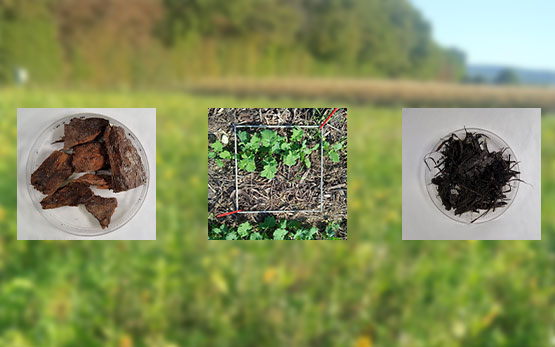Quality of agricultural soils
Increasing the carbon content (organic matter) of agricultural soils is a priority for Switzerland and its Cantons. This ambition also falls under the «4 per 1000» international initiative as part of the Lima-Paris Action Plan which aims to show that agricultural soils can play a crucial role in achieving food security and combating climate change.
Practices aiming to improve soil quality
Amending the soil with woody biomass (= wood inputs) can be an effective practice for increasing soil organic matter, and thus improving soil fertility in various ways. Firstly, it increases nutrient content and availability; secondly, the increase in organic matter facilitates root penetration into the soil and increases the soil’s usable water reserve capacity for crops, a factor that is becoming more and more important in the context of climate change.
The mode of application affects the distribution of the wood inputs in the soil profile as well as decomposition, carbon and nutrient dynamics, although these have not yet been quantified. To date, no official recommendation has been defined in terms of the mode of application of the wood inputs.
Woody biomass can also be used to combat weeds via two mechanisms. As they decompose, certain species can release allelopathic compounds, i.e. compounds capable of negatively impacting seed germination and rootlet growth. The allelopathic effects of the wood residues are poorly understood and vary according to species and soil type. Moreover, spreading in mulch prevents the light from reaching the soil, thereby stopping the germination of weeds. This weed-control approach is not common in field crops, and thus merits closer examination as a way of reducing herbicide use.
An innovative method introduced by Agroscope and hepia
Through a collaboration between Agroscope and hepia, this project aims to recycle wood residues (conifer bark and composting waste currently problematic for the companies generating it) by developing an innovative cropping system enabling the optimisation of C stocks and soil fertility and a reduction in (or forgoing of) herbicide use in response to a strong societal need. The wood residues (300 m3 x ha-1) were incorporated and/or spread as part of a field experiment on the Agroscope Changins site in order to observe the effect on successive crops – oilseed rape, green manure and wheat – and to quantify the change in the biophysical chemical properties of the soils. The multifactorial influence of these treatments on the soils, crops and weeds will highlight the potential of wood residues in agriculture.
Encouraging results would allow us to quantify soil restoration and weed control potentials to serve as a benchmark for future recommendations concerning the use of wood inputs in an agricultural context. Moreover, such results would allow the private partners involved in this project to solve their problem of how to advantageously manage their wood residues in both economic and environmental terms. This method could thus ultimately be recommended for other forestry-sector stakeholders generating non-recycled wood residues.






